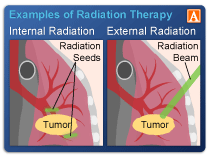
Diagnosed with Cancer? Your two greatest challenges are understanding cancer and understanding possible side effects from chemo and radiation. Knowledge is Power!
Learn about conventional, complementary, and integrative therapies.
Dealing with treatment side effects? Learn about evidence-based therapies to alleviate your symptoms.
Click the orange button to the right to learn more.
- You are here:
- Home »
- Blog »
- side effects ID and prevention »
- Ionising Radiation – Image, Treat, Damage
Ionising Radiation – Image, Treat, Damage

Ionising Radiation is a remarkable technology. Particularly in the world of oncology. There is no greater double-edged sword.
Radiological imaging, especially for me and my cancer, multiple myeloma, provides the ability to see inside the human body to see possible damage done by cancer. I have been scanned dozens of times in hopes of learning about what, where, how much cancer is in me.
As far a radiation therapy is concerned, I’ve read studies reporting that between 30%-50% of cancer survivors undergo radiation therapy. In my case, radiation handily zapped my cancer allowing me to walk pain-free within days.
Unfortunately, radiation fibrosis over the ensuing years damaged my nerve conduction weakening my lower body. As of the posting of this blog post I am not yet wheelchair bound but I can see this possibility clearly in my future.
Ionising Radiation provides:
- Accurate diagnostics-
- Cancer therapy-
- Long-term and late stage side effects-
So what’s a cancer patient to do? Cancer patients must be scanned repeatedly for years in order to manage their cancer. Yet each and every time the patient gets scanned with ionising radiation he/she increases the risk of DNA damage.
Possible solutions, in my experience, depend on venturing beyond conventional, FDA approved oncology. Meaning, the cancer patient must research and consider evidence-based but non-conventional therapies shown to either heal radiation damage or minimize radiation damage in the first place.
Two of the best examples of evidence-based, non-conventional therapies are:
“A growing body of literature supports the use of hyperbaric oxygen therapy in the prevention of radiation injury. This is usually in the setting of proposed surgery within a previously irradiated field where the likelihood of complications and difficult wound healing is high.[29]…”
“The observed effects of ionizing radiation are mediated mainly by oxygen-free radicals that are generated by its action on water and are involved in several steps of signal transduction cascade, leading to apoptosis. The oxyradicals also induce DNA strand breaks and protein oxidation. An important line of defense against free radical damage is the presence of antioxidants. Therefore, administration of antioxidants may ameliorate the radiation-induced damage to the intestine…”
I should also add that a generally low-dose approach to therapy needs to be added to the mix of the cautious use of ionising radiation therapy.
Imaging-
- Best Imaging Methods – SBP, MGUS, SMM
- Bone Imaging Can Make or Break Multiple Myeloma
- Myeloma Diagnostics- X-Ray, CT, Radiation
Ionising Radiation Damage-
- Healing Radiation-induced Dysphagia- Difficulty Swallowing
- Whole Brain Radiation Causes Collateral Damage aka Side Effects
- Side Effects- Radiation-Induced Lumbosacral Plexopathy
- Healing Chemo, Radiation-induced Nerve Damage
- Radiation-Fibrosis- Xerostomia aka Dry Mouth
- Small Cell Lung Cancer Therapy- Whole Brain Radiation
- Myeloma – RILP, CIPN, Myelopathy?
- Radiation-induced- Dermatitis, Dysphagia, CIPN, RILP
- Radiation for DCIS?
- Myeloma Side Effects- Radiation Damage
Have you undergone ionising radiation either for diagnostic testing or as a cancer therapy? Have you developed any short, long-term or late stage side effects?
Scroll down the page, post a question or a comment and I will reply to you ASAP.
Hang in there,
David Emerson
- Cancer Survivor
- Cancer Coach
- Director PeopleBeatingCancer
Radiology’s Ionising Radiation Paradox: Weighing the Indispensable Against the Detrimental in Medical Imaging
“Ionising radiation stands as an indispensable protagonist in the narrative of medical imaging, underpinning diagnostic evaluations and therapeutic interventions across an array of medical conditions. However, this protagonist poses a paradox – its inestimable service to medicine coexists with an undercurrent of potential health risks, primarily DNA damage and subsequent oncogenesis.
The narrative of this comprehensive review unfurls around this intricate enigma, delicately balancing the indispensable diagnostic utility against the non-negotiable commitment to patient safety…
In this critical discourse, the intricacies of ionising radiation are dissected, illuminating not only its sources but also the associated biological and health hazards…
The role of ionising radiation in radiology
Ionising radiation serves as the foundation of several major imaging modalities within radiology, which are indispensable in contemporary medicine for enabling the non-invasive visualisation of internal structures and processes…
Such techniques are vital in the early detection, accurate diagnosis, and successful treatment of various diseases, underpinning the crucial role of radiology in advancing patient care...
As such, it is incumbent to shed light on the possible hazards patients may encounter. Ionising radiation, by its very nature, possesses the capacity to inflict harm at the cellular level, exhibiting both immediate and long-term risks [7]…
The greater concern pertains to long-term risks – principally, the increased likelihood of malignancies and germline mutations that may propagate the risk to future generations following prolonged or recurrent low-dose exposure [8]…
Radiation Therapy Side Effects
“Other radiation therapy side effects you may have depend on the part of the body that is treated. To see which side effects you might expect, find the part of your body being treated in the following chart. Many of the side effects in the list link to more information in the Side Effects section…
Healthy cells that are damaged during radiation treatment usually recover within a few months after treatment is over. But sometimes people may have side effects that do not improve. Other side effects may show up months or years after radiation therapy is over. These are called late effects. Whether you might have late effects, and what they might be, depends on the part of your body that was treated, other cancer treatments you’ve had, genetics, and other factors, such as smoking.”


